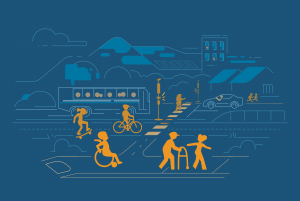
It’s Pedestrian Safety Month!
For the month of October, let’s talk about Safe Streets for All.
As stated by the US Department of Transportation, “walking can lead to healthier, quieter, cleaner, and safer streets. Walking can also improve local economies and enhance social and community engagement, which can lead to more vibrant, resilient, and livable spaces.”
However, in 2020 there were 6,516 pedestrians killed due to motor traffic in the United States. That equates to 18 pedestrians every day or 125 pedestrians every week. Why does this happen? Walking isn’t an inherently dangerous activity – but walking in an environment that’s built primarily for cars is. Recognizing this serious problem is not difficult, but reversing trends and creating safer walking and biking environments requires re-designing our streets so everyone feels safe, regardless of their mode of transportation.
For Pedestrian Safety Month, DCR wants to lift attention to intentional actions governments can take, not just to encourage people to walk and bike more often, but to commit to making the built environment safer for everyone. This is critical to improving the sustainability of our cities, reaching climate and equity goals, and improving the quality of life for everyone.



To make meaningful lasting improvement to safe mobility, DCR believes several things must be implemented:
- Slowing speeds of motorized vehicles in urbanized areas.
- Separating motorized and non-motorized modes of travel with dedicated bike and multi-use path networks.
- Connecting communities of all sizes with safe multi-modal transportation networks.
- Frequent Access to public transit for everyone within a five minute walk of where they live and work.
Safe Streets and Roads for All Grant Program
Fortunately, the US Federal Department of Transportation has introduced a significant new grant program that is allocating $1 billion per year for the next 5 years to improve road safety infrastructure in eligible US cities and regions. The program is based on the Safe Systems Approach, which anticipates human mistakes by designing roads to encourage safe speeds, and to protect all road users.
This is a landmark opportunity to develop safety plans and implement new infrastructure projects.
Below is a downloadable PDF of DCR’s thoughts and suggestions for developing robust safety plans – the critical first step in defining the problems locally – and prioritizing actions and projects to address them.

Want to work with us? Feeling inspired?
Contact us at info@dcrdesign.net or checkout our social medias: LinkedIn, X and Instagram
For more information visit:
Vision Zero, Safe systems approach, NHTSA and FHWA




